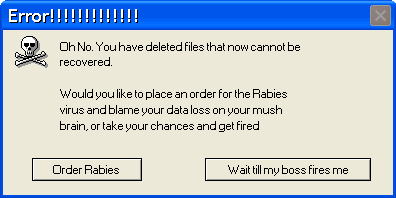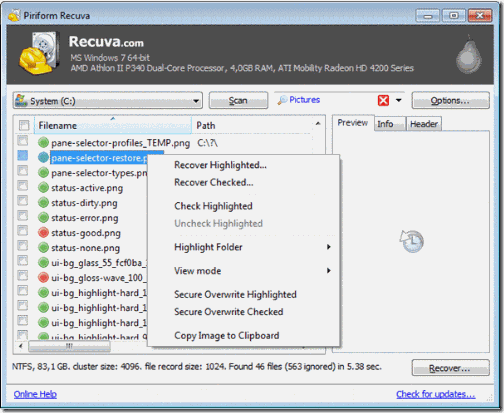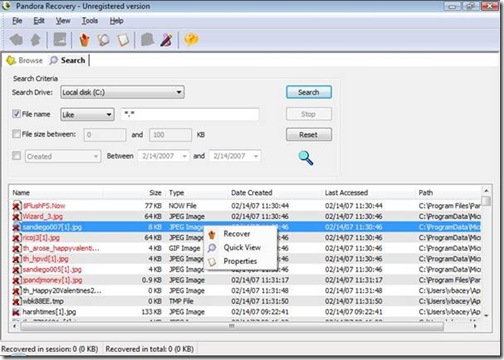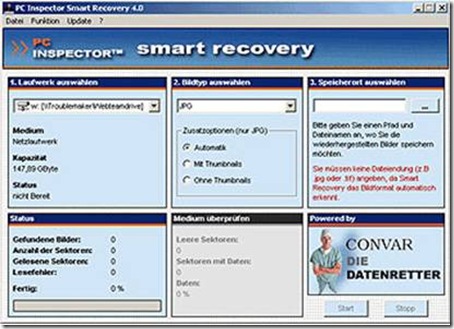Data Recovery for the Average User
Jul1Written by:
2012/07/01 09:05 PM 
 In business data is knowledge and knowledge is power. If you lose the data, you then lose knowledge and therefore lose power. If we value our data so much, then it is imperative that we have a mechanism to recover lost data.
In business data is knowledge and knowledge is power. If you lose the data, you then lose knowledge and therefore lose power. If we value our data so much, then it is imperative that we have a mechanism to recover lost data.
Whether from accidental or intentional deletion of data, one needs to have confidence in recovering any form of data loss.
Data can be lost by simple file deletions, formatting of hard drives, system failures, viruses and a host of other destructive processes. You can recover your files in such cases by using a good file or data recovery software.
Data recovery software can come in commercial licences, open source and of course freeware versions. Don’t be fooled! There are some excellent and very capable freeware data recovery tools out there.
Prevention is better than cure – Backup
The best data recovery process is to restore from back-up. The best defence against data loss is redundant and real-time backup. The most important thing that you might take away from this article would be to make backups and make them regularly.
Backups should be done on different media to the original source and should be kept in a separate location to the original source.
Flash drives are relatively cheap and have decent capacity. Flash drives a re small and easy to store. Flash drives and memory cards are the best media at this time to back up most of your important data.
Then there is the “Cloud”. Many people are often weary about backing their data up into the “Cloud”. If you make use of professional well known services, then your data is quite safe.
However, if your data is rather large then it might be necessary to invest in other backup processes.
How does data recovery software work?
When a file is deleted it immediately goes to the recycle bin. Recovering from the recycle bin is just a matter of un-deleting or moving the file back to the source folder.
The recycle bin has a limited amount of space to hold deleted files. The files are permanently deleted when the recycle bin gets too full. The oldest files are deleted first.
Emptying the recycle bin or using the hard delete feature (SHIFT + DELETE) makes the file far less accessible. This however doesn’t actually remove the file completely from the storage media.
Behind the scenes the computer’s file system removes the files index, and designates the space that the file is using as being available for future use when needed.
The entry in the operating system’s file allocation table or file index is removed. The file index is a mechanism used to identify where the file is physically stored on the hard drive. The bits and bytes that make up the file are still there on your hard drive. They are hidden until they are overwritten with the contents of another file. The space that they occupy is marked as empty and therefore available to be re-used. Parts of the file may stay on your hard drive for years, while other traces may be replaced within hours.
This means that the older the file is, the less chance there is of a successful recovery because it’s more likely to have been overwritten by another newer file.
So while it may seem that deleted files are inaccessible to you or the operating system, you can often recover them completely with professional data recovery tools. Data recovery software is designed to scan the storage media and locate any recoverable data, piecing it back together and providing it in a salvageable format.
The best data recovery applications provide a variety of features including:
- Preview of recovered files.
- Filtered and searchable results.
- Easy file restoration.
- Ease of use.
- Intuitive interface.
- Additional tools.
No data recovery software is perfect. If a file has been partially overwritten, the chances of recovery are low, even with the best recovery software. But if it hasn’t been too long since you accidentally deleted the file, the chances of complete recovery are pretty good.
The key here is to not write any thing new to the drive.
- Don’t install new software.
- Don’t save any data.
- Don’t reboot or shut the computer down.
Data recovery tools
Obviously there are times when data recovery is just beyond the capabilities of the average user. Such as a hard drive crash, or physical damage. In these cases it is best to seek the advice of a data recovery professional.
The tools listed below are aimed at the predominant Windows market as well as being open source or freeware. There are also many good commercial (pay for) data recovery tools available as well.
To have the best chance of successful data recovery, the data recovery tool should be installed prior to the data loss or possible be installed on an isolated drive or media.
Install the data recovery tool now or create a data recovery media, either a DVD disk or a flash drive. Better to have it installed and never need it than need it and not have it.
Recuva

This free file recovery tool by Piriform can recover lost data from any rewriteable media such as:
- Flash Drive.
- Camera.
- IPod.
- Hard disk.
Recuva is a user-friendly Windows-based tool. With Recova you can either use the Recova Wizard, or if you are brave enough, you can invoke the manual mode and search for the missing file yourself. It can even recover data from formatted or damaged disks.
Recova has an impressively fast recovering speed. The undelete process quite easy even for the technologically challenged. The recovery rate is high, made possible by its special deep scan features. There’s a portable version of Recuva available too to be carried in your flash drive.
Download Recuva
Pandora Recovery

Pandora Recovery has a lot of features when it comes to data recovery. Pandora Recovery supports multiple file systems such as FAT16, FAT32, NTFS, NTFS5 and NTFS/EFS formatted Volumes.
With Pandora Recovery you can recover files by simply searching for them. You can search by:
- File name.
- File size.
- Creation date.
- Last accessed date.
The Wizard like interface makes Pandora Recovery easy to use even for beginners. The user interface is clean and simple to understand and use. The folders are arranged in an explorer like tree-menu which helps you to quickly browse within your hard drive.
You can perform a quick search for files or folders or let it deep scan your system for any possible deleted files.
Once the scan is finished, you are presented with a list of files that were found and an estimated chance of recovery as well as a preview of the file content.
Download Pandora Recovery
PC Inspector Smart Recovery

PC Inspector Smart Recovery is a data recovery program that is primarily aimed at Flash Cards, Smart Media, SONY Memory Stick, IBM Micro Drive, Multimedia Card, Secure Digital Card (SD) or any other data device for digital cameras.
The user interface of PC Inspector File Recovery is easy to use even for beginners. PC Inspector File Recovery will scan your drive and automatically make files that can be recovered available from a “Deleted” folder in a familiar Explorer style navigation tree.
Some downsides of PC Inspector are that it is relatively slow. It also does not have a good record against formatted media.
Some of the features in PC INSPECTOR are:
- Finds partitions automatically, even if the boot sector or FAT has been erased or damaged.
- Recovers files with the original time and date stamp.
- Supports the saving of recovered files on network drives.
- Recovers files, even when a header entry is no longer available.
Download PC Inspector Smart Recovery
Conclusion
Data recovery does not have to be a nightmare, even for the not so technical user. With the right set of tools, most lost data can be successfully recovered. However, prevention is often better than cure.
- Make sure you backup your data regularly onto separate storage media.
- Stop and think before you make any deletions.
- Do a soft delete first, which transfers the data to the recycle bin rather than a hard delete using Shift + Delete.
If the data or media is damaged beyond your own personal skills to recover using available data recovery tools, then it would be wise to seek the help of a data recovery specialist.
blog comments powered by